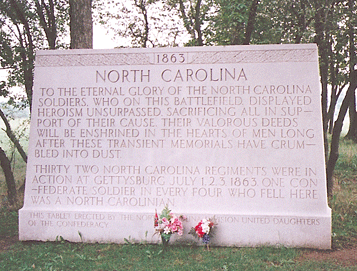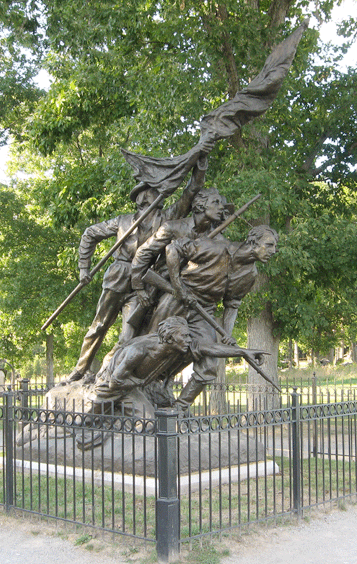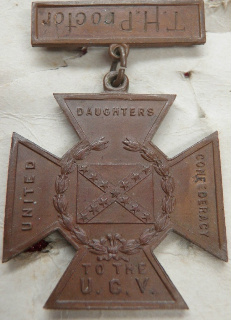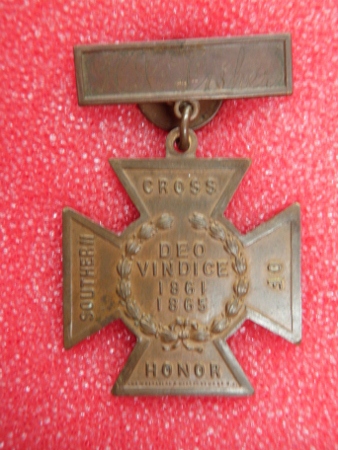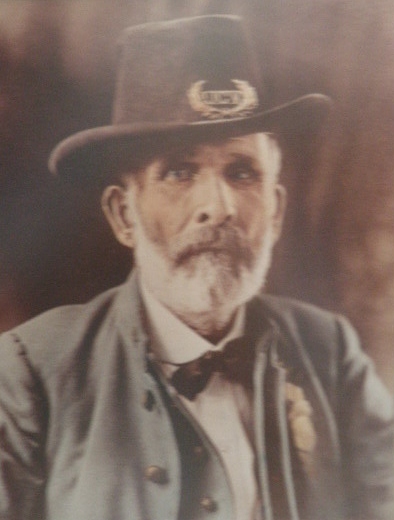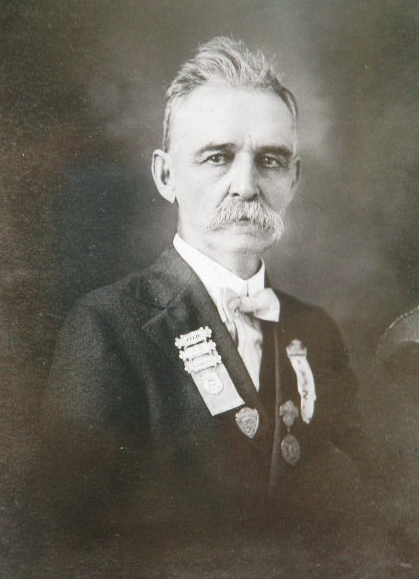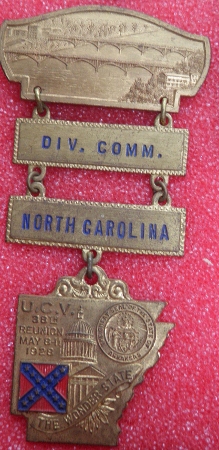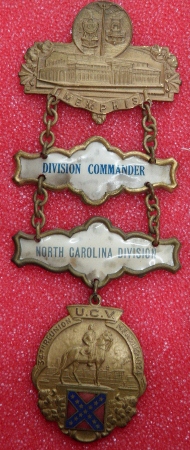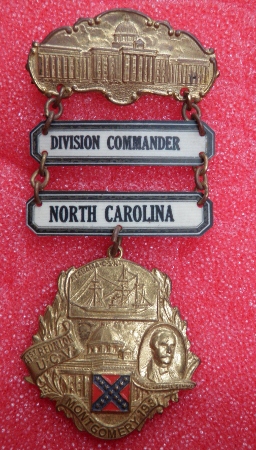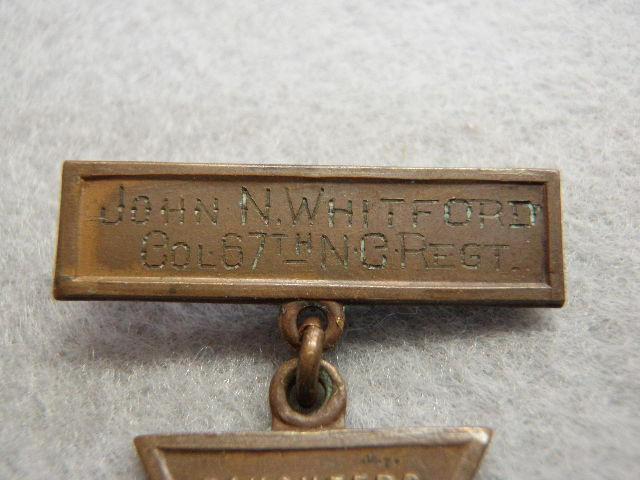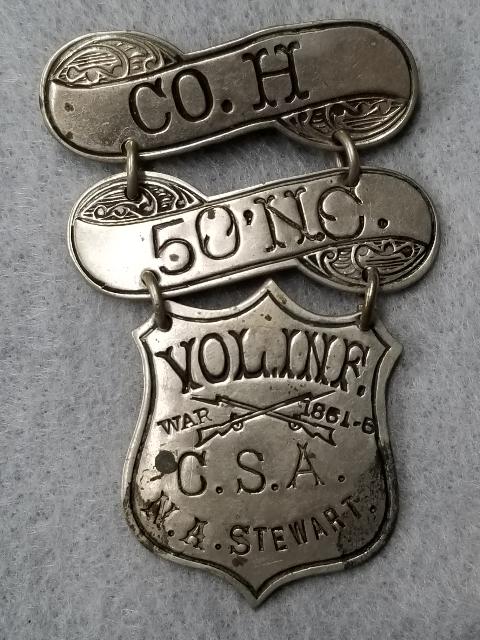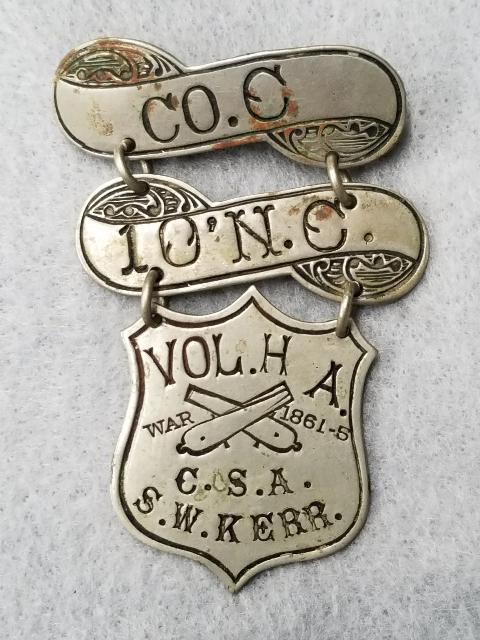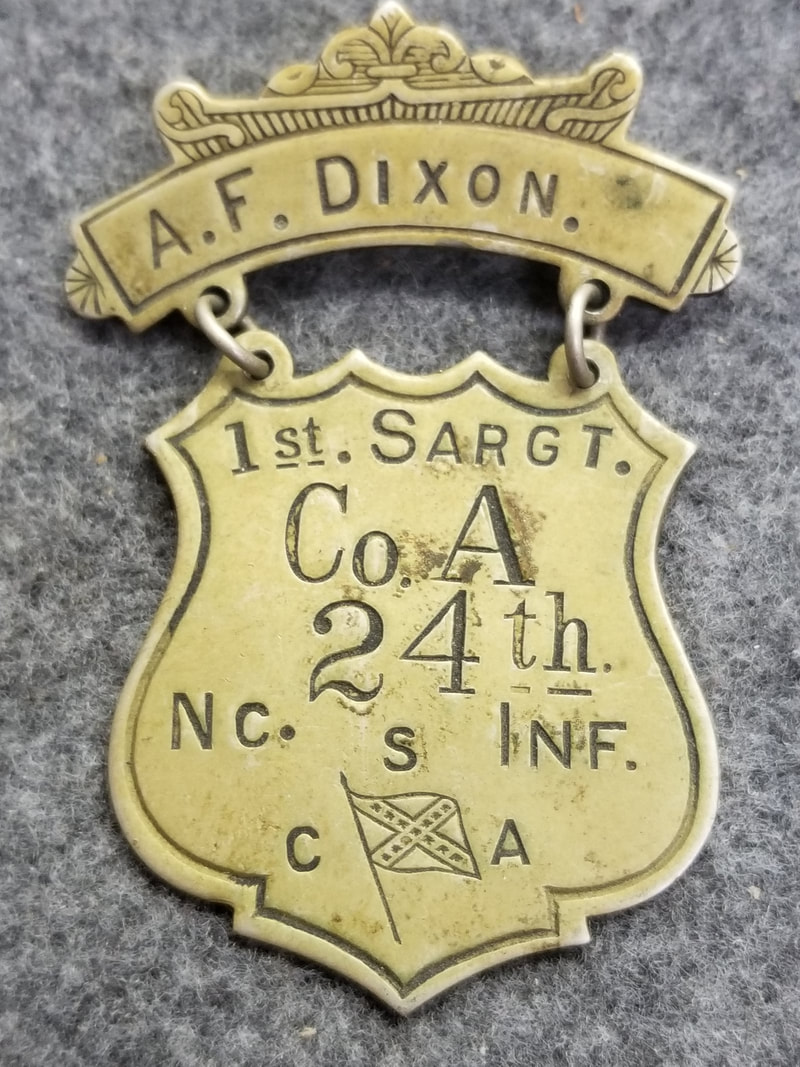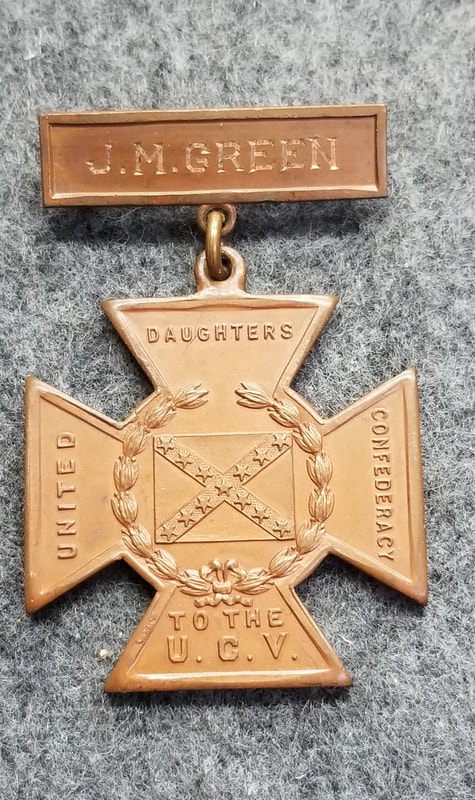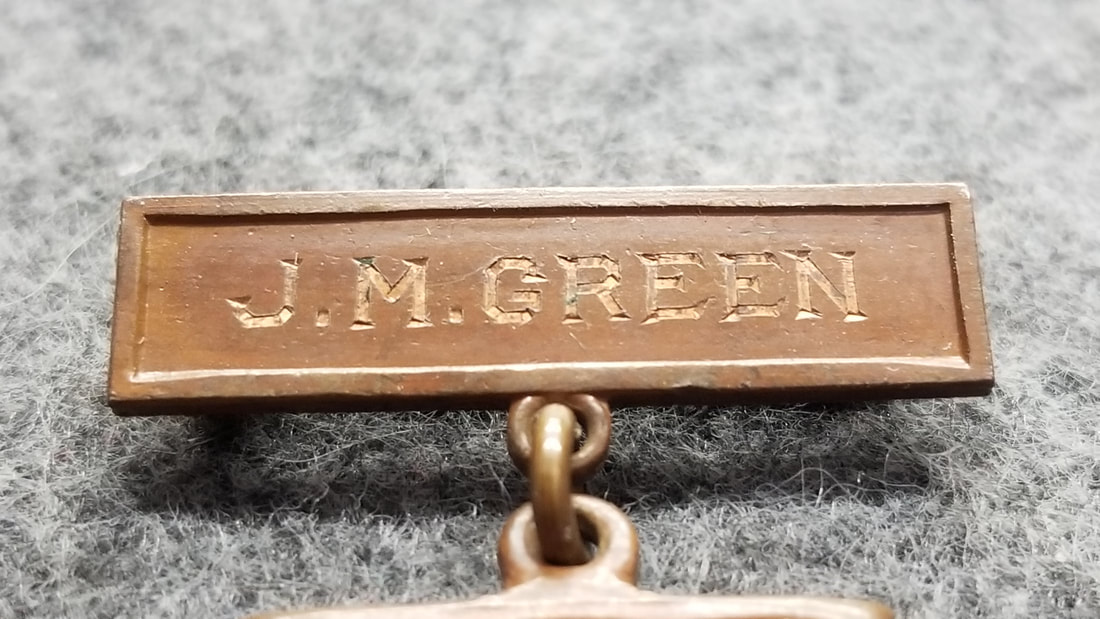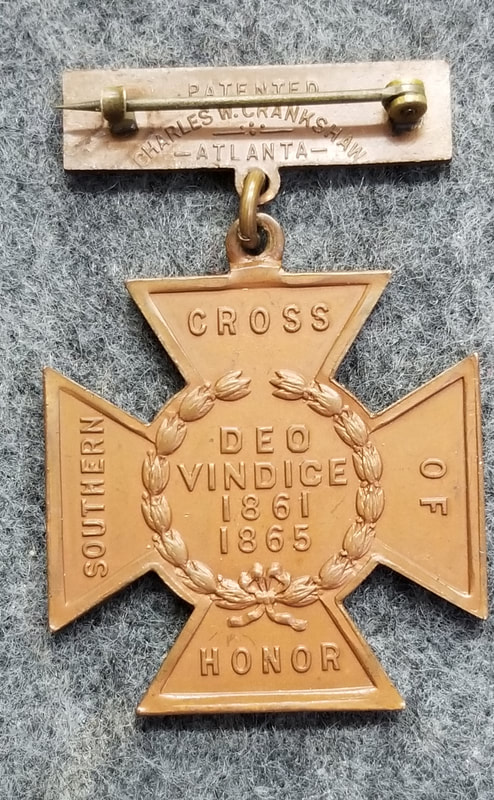The Badges on this page were all owned by North Carolina Confederate Veterans of the Civil War
The Badges shown below were purchased by Confederate Veterans during the 1880's-1890's to wear at Reunions,Coventions and Confederate Veteran meetings
The Southern Cross of Honor were issued by the United Daughters of the Confederacy to Confederate Veterans of Good record
Thomas Ham Proctor, Confederate Veteran
Co.K 23rd North Carolina Vol.Inf.
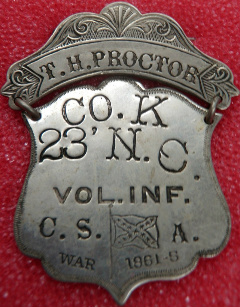
This is the named Southern Cross of Honor and Confederate Badge
belonging to Thomas Ham Proctor.He resided in Lincoln Co.North Carolina.
He enlisted at age 19,June 22,1861.Mustered in as a Private and was promoted to Sergeant in May,1862-August 1863.Present or accounted for untill wounded in the right hand and arm and captured at Gettysburg,Pa. July 1-5,1863.Right index finger amputated.Confined at Ft.Delaware,De.,untill paroled and exchanged on an
unspecified date.Detailed as provost guard in Nov.-Dec.1863.Reduced to Ranks in Nov.1864.Reported absent on detail through Dec.1864.Paroled at Charlotte,N.C. on May 24,1865.
He must not have figured out that he engraved his cross upside down till it was too late.
belonging to Thomas Ham Proctor.He resided in Lincoln Co.North Carolina.
He enlisted at age 19,June 22,1861.Mustered in as a Private and was promoted to Sergeant in May,1862-August 1863.Present or accounted for untill wounded in the right hand and arm and captured at Gettysburg,Pa. July 1-5,1863.Right index finger amputated.Confined at Ft.Delaware,De.,untill paroled and exchanged on an
unspecified date.Detailed as provost guard in Nov.-Dec.1863.Reduced to Ranks in Nov.1864.Reported absent on detail through Dec.1864.Paroled at Charlotte,N.C. on May 24,1865.
He must not have figured out that he engraved his cross upside down till it was too late.
P M Faggart,Confederate Veteran
Co.E,2nd North Carolina Junior Reserves Vol.Cav.
P.M.Faggart
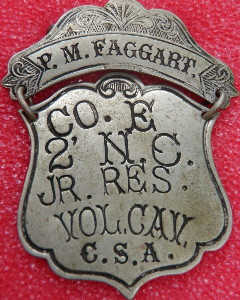
P.M.Faggart was a member of the
Co.E 2nd North Carolina Junior Reserves Vol.Cav.
Confederate States of America
Birth:8 October 1847 Cabarrus County,North Carolina
Death:31 December 1919 Cabarrus County,North Carolina
Co.E 2nd North Carolina Junior Reserves Vol.Cav.
Confederate States of America
Birth:8 October 1847 Cabarrus County,North Carolina
Death:31 December 1919 Cabarrus County,North Carolina
W.C.Baldwin,Confederate Veteran
Co.G,44th North Carolina Vol.Inf.
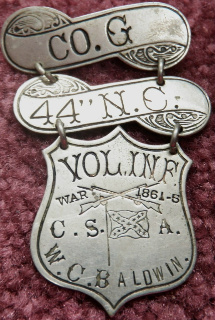
W.C.Baldwin,Private
Born in Orange Co.North Carolina at
age 15,March 8,1862.Present and accounted for
untill discharged on or about July 3,1962
Andrew J Hutchinson,Confederate Veteran
Co.I,25th North Carolina Vol.Inf.
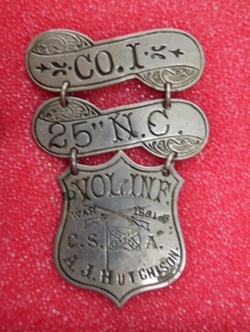
Andrew J Hutchinson,Private
Co.I,25th North Carolina
Confederate States of America
Resided in Buncombe Co. and enlisted in Lenoir Co.
at age 20,May 12 1862 for the war.Present and accounted for
through December,1863.No further records.
H.C.Fisher,Confederate Veteran
Co.A,22nd North Carolina Vol.Inf.
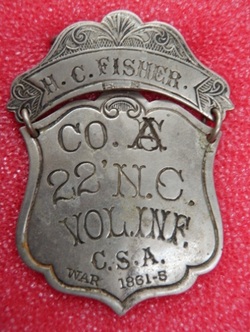
Henry C.Fisher,Private
Co.A,22nd North Carolina Vol.Inf.
Confederate States of America
Resided in Caldwell Co. where he enlisted at age 19
March 19 1862."Bruised from shell" at Frayser's Farm.
Virginia,June 30.1862.Hospitalized at Richmond VA.Returned to duty on an unspecified date.Captured at or near Cold Harbor,Va.,June 2 1864.Confined at Point Lookout Maryland,
untill transferred to Elmira,New York,July 12 1864.Released at Elmira on July 3 1865,after taking the Oath of Allegiance
John H C Burch,Confederate Veteran
Co.H 24th North Carolina Vol.Inf.
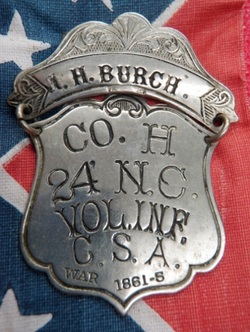
John H C Burch,Sergeant
Co.A,24th North Carolina Vol.Inf.
Confederate States of America
Resided in Person Co. where he enlisted
at age 18,June 6,1861.Mustered in as Private
and was promoted to Corporal on June 1,1864.
Promoted to Sergeant on July 31,1864.Present
or accounted for through Febuary,1865.
John H C Burch
Madison L Efland, Confederate Veteran
Co.D 53rd North Carolina Vol.Inf.
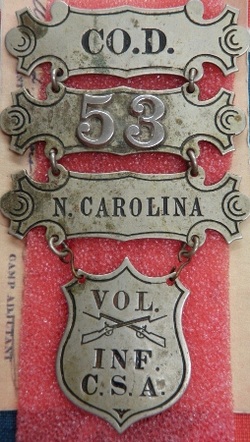
Madison L Efland,1st Lieutenant
Co.D 53rd North Carolina Vol.Inf.
Confederate States of America
Born: 14 Feb 1844
Born in Guilford Co. where he resided as a farmer prior to enlisting
at age 18.Elected 3rd Lt.on April 30,1862.Reported present and accounted for on surviving company muster rolls thru Febuary,1863.
Wounded in the right leg at Gettysburg,Pennsylvania,July 1,1863.Captured at Hagerstown,Maryland,July 5,1863.Hospitalized
at Frederick,Maryland,July 6,1863.Confined at Fort Delaware,Delaware,July 10,1863.Transferred to Johnson's Island,Ohio,July 18,1863.Promoted to 1st.Lt. on November 2,1863,while a prisoner of war.Paroled at Johnson's Island on February 24,1865,and transferred to City Point,Virginia,for exchange.Paroled at Greensboro,North Carolina on May 29,1865.
Co.D 53rd North Carolina Vol.Inf.
Confederate States of America
Born: 14 Feb 1844
Born in Guilford Co. where he resided as a farmer prior to enlisting
at age 18.Elected 3rd Lt.on April 30,1862.Reported present and accounted for on surviving company muster rolls thru Febuary,1863.
Wounded in the right leg at Gettysburg,Pennsylvania,July 1,1863.Captured at Hagerstown,Maryland,July 5,1863.Hospitalized
at Frederick,Maryland,July 6,1863.Confined at Fort Delaware,Delaware,July 10,1863.Transferred to Johnson's Island,Ohio,July 18,1863.Promoted to 1st.Lt. on November 2,1863,while a prisoner of war.Paroled at Johnson's Island on February 24,1865,and transferred to City Point,Virginia,for exchange.Paroled at Greensboro,North Carolina on May 29,1865.
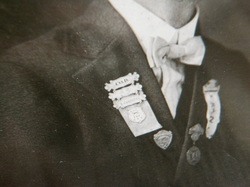
Here he is wearing his Badge.
William Alexander Smith,Confederate Veteran
Co.C,14th North Carolina Vol.Inf.
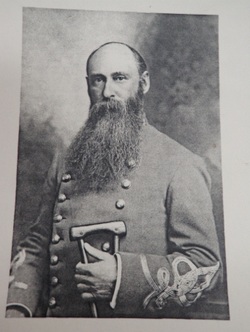
William Alexander Smith,Private
Co.C,14th North Carolina Vol.Inf.
Confederate States of America
Born in Anson Co.North Carolina where he resided as
a student prior to enlisting at Camp Ellis,Virginia,July 22,1861.
Present and accounted for untill wounded in the left leg at
Malvern Hill,Virginia July 1,1862.Reported absent wounded
untill discharged on November 11,1862,by reason of wounds
received at Malvern Hill.
Private Smith lost his left leg at Malvern Hill.He later became the
Commander of The North Carolina United Confederate Veterans on several different occasions.The below listed badges were his as Commander.
Colonel. John N Whitford
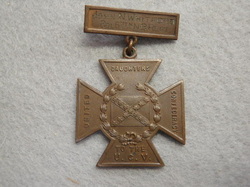
Colonel John N Whitford
From: New Berne,Craven Co.,North Carolina
Colonel of Whitford's Partisans Rangers
67th North Carolina State Troops
67th North Carolina Troops
By RUFUS W. WHARTON, Lieutenant-Colonel
The Sixty-seventh Regiment (N. C.Troops), was organized in January, 1864, and
was composed of nine companies of infantry and one of cavalry. The several
companies had been organized a considerable time prior to the organization of
the regiment. Some of them in the early part of the war, and had been employed
on outpost duty in the vicinity of New Bern and Washington, N. C., after those
towns fell into the hands of the enemy early in 1862. These companies and the
regiment, after its organization, were paid, fed and clothed entirely by the
State of North Carolina, were subject to the orders of the Governor of the
State and could not be removed beyond the limits of the State without his
consent and order. In fact, however, they were under the immediate command and
subject to the orders of the Confederate officer in command of the Military
district of Eastern North Carolina.
The Field Officers and Staff of the
Regiment were :
JOHN N. WHITFORD, Of Craven county,
Colonel.
RUFUS W. WHARTON, Of Forsyth county, Lieutenant-Colonel.
EDWARD
WHITFORD, Of Craven county, Major.
SAMUEL G. SCHENCK, of Beaufort county,
Adjutant.
THOMAS M. ROBINSON, of Beaufort county, Quartermaster.
WILEY F.
HIGGINS, of Craven county, Commissary.
JOSEPH GRAHAM, of Orange county,
Surgeon.
WILLIAM E. MORROW, of Orange county, Assistant
Surgeon.
The writer of this sketch, at the time of his appointment by
Governor Vance, belonged to the Army of Northern Virginia, in which he had
served from and including the first battle of Bull Run up to that time. He is,
therefore, unable to give a detailed account of the services of the several
companies composing the regiment prior to the time joined the same, which was
in February, 1864; soon after the Pickett expedition against New Bern. The
regiment participated in that expedition, being a part of the troops intended
to attack Fort Anderson, opposite New Bern, on the north side of Neuse river.
The conditions under which the attack was to be made did not occur, and no
attack was made. When the writer joined the regiment he found seven companies
encamped at Coward's bridge, on Contentnea, twelve miles below Kinston. They
were:
Company A, from Craven, James H. Tolson, Captain
Company B, from
Craven, Stephen Barrington, Captain
Company C, from Wilson, D. W. Edwards,
Captain
Company E, Charles A. White Captain
Company F, from Craven, David
P. Whitford, Captain
Company G, Asa W. Jones, Captain
Company I, from
Pitt, Edward F. White, Captain
The other three companies,
Company
D, from Craven, Daniel A. Cogdell, Captain
Company H from Duplin, Jones and
Craven, Christopher D. Foy, Captain
Company K (cavalry), from Wayne, Joseph
D. Myers, Captain
were encamped some miles in front, nearer the enemy's
lines, and engaged in scouting and doing picket duty in the vicinity of New
Bern and Washington. Captain Foy was a man of 6O years, was six feet and a half
high, wore a long, flowing white beard that reached to his waist and was unique
both in personal appearance and in the influence which he wielded over the men
of his company. He was familiarly known in the regiment by the name of
"Tecumseh." When the writer first saw him he was marching at the head of his
compapy of 65 or 70 men, who were following him, Indian-like, in single file.
As the men had had but little opportunity for company and none at all for
battalion drill, the companies at regimental camp, spent the next few weeks in
these exercises. About the last of April, 1864, another expedition against New
Bern was undertaken, this time under command of Major-General R. F. Hoke, who
had just won his promotion by the brilliant battle and capture of Plymouth, N.
C. In the expedition the Sixty-seventh headed the column. Nothing of importance
happened until we reached Deep Gully, eight miles from New Bern. Here we came
on a strong outpost af the enemy which made some resistance, but was quickly
driven in by the Sixty-seventh, which remained in this vicinity for the next
two days, while General Hoke proceeded with the balance of the troops, down the
Trent, on the south side, to the vicinity of New Bern. Before the capture of
New Bern, which was almost a certainty, was accomplished General Hoke, to his
great disappointment, received orders to hasten back to Virginia with his
command. He arrived in Petersburg just in time to save that city from capture.
The regiment returned to its former position and continued in the same service
as before for a short time, but was soon removed to the vicinity of Kinston,
where it remained, doing outpost duty until October, when it was ordered to
Washington and Plymouth, N. C., to relieve the troops stationed at those
points. Occasionally we had to repel incursions made by the enemy, outside of
his lines and sometimes we made incursions into the territory occupied by him.
In one of these raids a squad of men, about fifty strong, led by Major
Whitford, proceeded down Neuse river on the north side to a point several miles
below New Bern, crossed the river in boats at night and made its way to the
Atlantic & North Carolina Railroad at a point between New Bern and
Beaufort, where it arrived about daylight on Monday morning. The object of the
raid was to capture General Palmer, the officer then in command at New Bern. It
was understood by us that he was in the habit of spending Sunday at Beaufort,
returning to New Bern Monday morniing. While arranging to capture the train,
our force was discovered by some colored people who notified the Yankee troops
at a fort a mile away. The party finding that their presence had been
discovered and being many miles inside the enemies lines, considered it
imprudent to await the arrival of the train. It, however, passed while they
were in hearing distance and, as they afterward learned, had General Palmer
aboard. Another party, under the lead of Levi Howland, of Carteret County, blew
up and so damaged the lighthouse at Cape Lookout that it was never of any
further use. This enterprise was a daring and dangerous one. The party had to
cross the sound, seven or eight miles wide, in small boats, running the risk of
capture by a steamer which the Federals kept on guard constantly near the
lighthouse. Of course the thing had to be done at night. Arriving at the light
house they first notified the persons in charge to keep in door and make no
alarm, at the peril of their lives. They then placed a keg of powder, which
they carried with them, in the lighthouse and connected it with a trail of
powder to which they applied a slow match. The match failed to ignite the
powder and as the steamer on guard had begun to move up near to the lighthouse,
one of the party procured from 1he keeper's house a shovel of live coals and
running near the door of the lighthouse, threw the coals on the trail of
powder. The keg of powder exploded and the tall structure was so badly wrecked
as to be unsafe for further use. In June, 1864, a strong party of Federals and
Buffaloes, as the natives who joined the enemy were called, attempted to
capture Captain Cogdell and his company. They were on outpost duty ten miIes
below Kinston on the south side of the Neuse. Captain Cogdell was on the alert
and did not fall into the trap set for him. They did, however, capture Colonel
G. N. Folk, of the Sixty-fifth North Carolina (Sixth Cavalry). At the time he
was attempting to reach Cogdell. As before stated, the Sixty-seventh was
ordered to relieve the troops stationed at Washington and Plymouth N. C., in
October, 1864. The writer and three companies stopped in Washington while
Colonel and Major Whitford, with the other seven companies proceeded to
Plymouth. Plymouth is only eight miles above the mouth of the Roanoke and was
protected by the Confederate ram Albemarle, which was anchored a short distance
below the town and which had done such fine service the previous spring at the
capture of the town from the Federals, though defended by several gunboats on
the river and several thousand troops, well fortified, on the land. It was a
part of the duty of the garrison to keep a strong guard on the ram day and
night, to protect it from any effort that might be made secretly to destroy or
injure it. About a week after Colonel Whitford assumed command at Plymouth,
during dark night, a small steam launch which had approached without noise or
any other sign of its presence, was suddenly discovered by the sentinenl on
duty very near the ram and approaching it rapidly. The sentinel immediately
fired on the approaching boat, but in an instant it struck the side of the ram
and at the same time exploded a torpedo or some explosive of great force. The
parties in the launch attempted to back it off, but failed. In the darkness and
confusion one of the boat's crew jumped into the river and escaped unnoticed.
Two others and the launch were captured. A large hole was torn in the side of
the ram by the explosion and it immediately sank to the bottom, though a
portion of it still remained above water. Two days thereafter several Federal
gunboats came up the river and shelled the town until the garrison was
withdrawn. The party who escaped by swimming ashore was Lieutenant Cushing, of
the Federal navy, and was entitled to the credit of planning and carrying out
the attack on the ram. Immediately after the abandonment; of Plymouth, the
writer was ordered to remove all the military stores in Washington and withdraw
from the place. There were quite a large number of heavy guns mounted in the
several forts in and around the town--some weighing 10,000 pounds, and no means
of getting them to a place of safety except by hauling them seven miles into
the country. Two weeks were spent in executing the order. After the evacuation
of Plymouth and Washington, N. C., Colonel and Major Whitford, with the greater
part of the regiment, returned to Winston, while the writer with the balance
was stationed at Greenville for a few weeks. About this time Colonel Whitford,
with a part of the regiment, went to Hamilton, on the Roanoke, to repel an
invasion of that section by the enemy who came up the river in gunboats. The
enemy were soon driven back with the loss of one of the gun-boats. In January,
1865, the enemy made a demonstration in force from New Bern, on Kinston, and
came with in four or five miles of the town, but were promptly driven back by
the Sixty-seventh and other troops then at Kinston. Nothing else of importance
occurred in that district until the latter part of February, 1865, when General
J. D. Cox with a large Federal army advanced from New Bern on Kinston, with the
purpose of making a junction, at some point further west, with Sherman, who was
coming from South Carolina in that direction. General Braxton Bragg, with such
Confederate troops as could be spared from other points, was sent to meet him.
The two armies met at South West Creek four and a half miles east of Kinston,
where for two days, 8th and 9th of March, 1865, there was sharp fighting and
several hundred prisoners captured, mostly by the division of General R. P.
Hoke, to which the Sixty-seventh was attached. On the first day of the battle
General Hoke, with his command, the Sixty-seventh, being in front, executed
quite a brilliant manoeuver by which he surprised and after a short fight
captured about 700 Federals. The next day General Hoke made another attempt to
outflank and surprise the enemy on another part of his lines. This time the
Federals were on the alert and gave him such a warm reception that he withdrew
to his own side of the creek. After contesting the advance of the enemy for
four days, General Bragg withdrew to the north side of the Neuse, destroyed the
bridge over the same and marched in the direction of Goldsboro. General Hoke
with his division, remained in the vicinity of Kinston two or three days longer
and then joined Bragg at Goldsboro. At Goldsboro the Sixty-seventh and
Sixty-eighth, the latter commanded by that brave officer and excellent
gentleman, Lieutenant-Colonel Edward C Yellowley, were formed into a brigade
and placed under command of Colonel John N. Whitford, of the Sixty-seventh . At
that time the Sixty-seventh reported 700 for duty and the Sixty-eighth 300;
total 1,000,( 99 Vol. Official Records Union and Confederate Armies, p. 1424.)
The Sixty-seventh and Sixty-eighth were ordered from Goldshoro to a bridge over
the Neuse river a short distance east of Bentonville. We reached the bridge
about noon, when the enemy appeared in large numbers on the opposite, the south
side. On that side the river is bordered by a swamp about half a mile wide.
After posting a strong skirmish line on the south side, in the swamp, the
balance of the brigade formed a line on the north side above and below the
bridge and near the river. Early next morning the enemy attacked in force and
gradually drove our skirmishers back, who, when near the bridge, quickly
crossed over, setting fire as they did so to some combustible material which
had been placed there. The brigade remained near the bridge until it was nearly
consumed and then withdrew, the object having been accomplished which was to
prevent the enemy from crossing to the north side of the river during the
battle of Bentonville. We then joined General Johnston's army at Smithfield a
day or two after the battle of Bentonville. We remained at Smithfield one day
and then marched eastward by way of Wilson and Tarboro. Our purpose was to get
to the rear of the enemy and interrupt and destroy as much as possible the
enemy's transportation, which was by both river and rail fron New Bern via
Kinston and Goldsboro. The Sixty-eighth remained near Tarboro. The
Sixty-seventh proceeded to Greenville and went into camp in the grove at the
north end of the Greenville bridge. These two regiments were accompanied by a
battalion of the Thirty- sixth North Carolina (Second Artillery) acting as
infantry, and commanded by Lieutenant-Colonel John D. Taylor. From Tarboro a
small company of cavalry was sent over to Greene county in the direction of
Kinston, which had several skirmishes with the enemy's forage parties, in one
of which Lieutenant Titus Carr, in consequence of the falling of his horse, was
captured. From Greenville, Company A, of the 'Sixty-Seventh, a large and fine
company, commanded by Captain James H. Tolson, was dispatched to Neuse river,
between New Bern and Kinston, with instructions to operate both on the river
and railroad running from the former to the latter place. Many of the men in
this company were citizens of Craven county and familiar with the country and
would doubtless have done good service had not the war practically ended a few
days thereafter. They tore up the railroad at one point and captured and burnt
a steamer and two barges on the river, all loaded with supplies for the
Federals. On 9 April Colonel Jno. N. Whitford made the following report (98
Official Records Union and Confederate Armies, 1134) "On 5 April, Lieutenant
Marshall, Com- pany F, Sixty-seventh North Carolina, burnt the steamer Mystic,
near Maple Cypress. On the same day Captain Tolson, Company A, Sixty-seventh
Regiment, destroyed a transport loaded with commissary stores near Cowpen
Landing, and on the 7th instant four privates of Company A, viz: George Hill,
Turner May, William Salter and R. Brewer, captured and burned a side-wheel
steamer, the Minquas, and two barges, all loaded with quartermasters and
commissary stores. Very little was saved from the boats." The four men named
opened fire with their muskets on the steamer which was immediately run aground
on the other side of the river. The crew and passengers, of whom there was a
considerahle number aboard, jumped into the mud and water on the shore side and
made their way into the swamp. The captors having no boat, swam over to the
steamer and after securing the flag and papers of the steamer and a few other
articles, set fire to all three of the vessels and returned to their own side
of the river. The flag and papers were brought to the writer of this sketch at
Greenville. In the same report Colonel Whitford further says: "On the 5th
instant Captain Joseph Y. White, Company E, Sixty-seventh Regiment, captured
fifteen Negroes and two Yankees at Biddles Ferry engaged in trying to raise a
sunken craft. The reason I have not forward you a report of my command is
because the companies and regiments are scattered so far apart that it is
impossible to get a report from them." These were bold operations in the rear
of the whole Federal army. There were many other daring feats, but the falling
back ot Johnston's army prevented further official reports and the lapse of
time and the death of so many actors prevent an authentic and accurate recital
of them now. It should be remembered that the Sixty-seventh and Sixty-eighth
were North Carolina Regiments, which were never mustered into Confederate
service and were paid by the State. About this time some veterans of Lee's army
arrived in our camp and told us the sad news of Appomattox. In a few days the
country was full of parties of disbanded Confederate soldiers returning to
their homes. Knowing that our cherished cause was lost in all things except in
the influence which the heroic deeds, the cheerful endurance of hardships and
the dangers by the Confederate soldiers and the patriotic and unselfish
devotion of the women of the Confederacy would exert upon all who should
hereafter read the true history of the four years' war, the Sixty-seventh was
also disbanded. Most of the officers and men were from the eastern counties of
the State and went directly to their homes. The writer with Captain J. M.
Robinson, and a few officers and men who were from the counties of Wayne and
Green, made their way to Stantonsburg in the latter county, and on 28 April,
1865, were paroled by a detachment of Federals from Goldsboro. The writer had
been in the service four years less two weeks. Many of the men and officers
were much affected by this termination of all our labors and sufferings in the
cause of self-government. The writer well remembers the inconsolable grief of
Lieutenant John W. Aldridge, now a resident of Pamlico county, a good soldier
and man. May he live long and prosper.
Rufus W. Wharton
Washington, N. C.
28 April, 1901
1st Battalion, N.C. Local Defense Forces ( Whitford's Battalion)
& 67th Regiment, N.C. Troops
Here is a brief history of the founding of the companies that went to make
up the 1st Battalion NC Troops, their service with the Battalion and their
transfer to the 67th Regiment upon it's formation.
On June 25, 1861,
John N. Whitford, a merchant of New Berne (Craven Co.) aged 24, began the
recruiting of a company of for the defense of New Berne. In the summer of 1861,
this company was organized as an artillery company and was stationed at Fort
Thompson, near New Berne. On October 17, 1861, the company was officially
mustered into State service as Co. I, 10th NC Regiment (1st NC Artillery). The
company was transferred to Confederate service on October 27, 1862. The company
remained at Fort Thompson, and, although records are scarce, it is assumed the
company was trained with heavy (fortification) artillery. In March, 1862, the
Union attacked and captured New Berne. Fort Thompson was evacuated and the
company moved to Kinston. At Kinston, the company was converted to an infantry
unit and assigned with other displaced artillery companies to a battalion,
under the command of Brig. Gen. Lawrence O'B. Branch, Army of the Pamlico.
Within a few days, NC authorities began to fear a similar attack against
Wilmington and the company was again assigned artillery duties and sent to
coastal defense fortifications near Old Brunswick, NC. The company was not long
to remain here, reporting as an infantry unit engaged in scouting and outpost
duties outside New Berne at Swift Creek (Craven Co.) by June, 1862. The company
took part in a skirmish against marauding Union troops at Batchelder's Creek,
near the Neuse river in Craven Co. on August 20, 1862. The company remained at
Swift Creek, reporting as Company I, 10th NC Regiment through the winter of
1862/63. In March, 1863, the company and Captain Whitford were especially
mentioned in dispatches by General Pettigrew, noting their efficient and
gallant service against crushing odds. In April, 1863, the company was divided
into two companies and officially designated a battalion, at which time Captain
Whitford was promoted to Major in command. The two companies were designated
1st Battalion, NC Local Defense Troops, Co. A, (Capt. Edward Whitford,
commanding) and Co. B. (Capt. Stephen G. Barrington, commanding). (Note: All of
the men in Co.'s A & B at their foundation had previously served in 1st Co.
I, 10th Regiment NC Troops. It is not unusual to find men who had served in
1st Co. I. NC Troops, then Co. A or B, 1st Battalion NC Local Defence forces,
then were transferred to an another company within 1st Battalion raised later,
then again transferred to another new company even later. It seems that during
the formation of later companies [excepting perhaps Co.'s C & D],
experienced men were transferred into them from existing companies already in
the Battalion. When looking at rosters, always consult later rosters to see if
a particular soldier might have transferred to a company raised later.) Co. C
(Captain Daniel W. Edwards, commanding) appears to have already been organized
in Greene and Lenoir counties, being enlisted into State service in January,
1863. It was assigned to the Battalion in April or May, 1863. Co. D (Captain
Daniel A. Cogdell, commanding) war organized with recruits from Wayne, Lenoir
and Pitt counties, beginning in January, 1863. It was accepted into State
service on February 21, 1663 and was assigned to the Battalion in April or May,
1863. (It is not known exactly whether Co.'s C & D were raised
independently or raised for the purpose of being added to the Battalion, but at
the time of the founding of the Battalion or soon after, the Battalion appears
to have consisted of Co.'s A -- D.) Co. E (Captain Charles A. White,
commanding) was organized at Camp Burney, near Greenville, Pitt Co. in early
1863 and was accepted into State service on February 10, 1863. It was assigned
to the Battalion in April or May, 1863. It appears that Co. E was organized for
the purpose of being added to the Battalion, as it appears to have joined the
Battalion in July or August, 1863. Co. F (Capt. David P. Whitford, commanding)
was organized in Craven Co. in April and June, 1863. It appears that Co. F was
organized for the purpose of being added to the Battalion, as it appears to
have joined the Battalion in July or August, 1863. Co. G (Capt. Asa W. Jones,
commanding) also seems to have been organized at Camp Burney for the specific
purpose of being added to the Battalion (Capt. Jones previously having served
in Co. E. of the Battalion), entering State service soon after June 30, 1863.
It was attached to the Battalion in July or August, 1863. Co. H (Capt.
Christopher D. Foy, commanding) is shown as having been organized between late
June and early August, 1863. The lieutenants of the company were appointed by
the State on August 12 and 20th, 1863, and the company was enrolled in State
service on August 20th, 1863. This company seems to have had men from a wide
area across eastern North Carolina, with significant numbers of men from
Craven, Lenoir, Duplin, Jones, Onslow, and Sampson counties. Captain Foy had
earlier served as captain Co. A, Nethercutt's Partisan Ranger Battalion (8th
Battalion, NC Troops). There are records that indicate that he was invalided
for service and had to resign his commission due to a broken leg suffered in
the fall of a horse while in the service, but it is not known if that injury
occurred while he was captain of this company or while serving with the
previous company. It appears that the company was commanded by Francis M. Foy
later in the War. Co. I (Capt. Edward F. White, commanding) began organization
in Pitt Co., was accepted into State service on September 22, 1863 and was
attached to the Battalion at this date or soon after. Captain White, 2nd Lt.
George White, most of the non-commissioned officers and a number of men in this
company had previously served in earlier-organized companies within the
Battalion. Co. K (Captain Joseph D. Myers, commanding) began organization in
Pitt Co. and was accepted into State service and assigned to the Battalion
about September 30, 1863, as a "mounted infantry" company. Again, Captain Myers
and many of the men in this company had previously served in other companies
within the Battalion. With the organization of these ten companies into the
Battalion by late 1863, the Battalion had increased to the size of a full
regiment; indeed, some companies signed their November -- December muster rolls
as "67th Regiment, NC Troops" while other signed their muster rolls as
"Whitford's Battalion". On January 18, 1864, the Battalion was officially
renamed the 67th Regiment, NC Troops by NC State authorities. All the companies
in the Battalion were transferred to the 67th Regiment and carried over their
previous company letter designations to the new regiment. Note that the
regiment never was enrolled in Confederate service, but remained a "State
service" regiment from the date of it's founding until the end of the War.
Union troops made a number of raids into north-eastern NC from New Berne and
surrounding areas in late 1862 and 1863, either to disrupt traffic on the
Wilmington-Weldon railroad or to attempt to destroy gunboats being built on or
near the Roanoke river. In July, a force of about 3,000 Union troops, with 6
artillery pieces and a squadron of cavalry, attacked Tarboro NC and burned Lt.
Gilbert Elliott's boatyard there, destroying what would have been an ironclad
gunboat and also a smaller gunboat and a large number of tools and materials.
As part of this raid, Union General Edward E. Potter's men overwhelmed an
outpost stationed by men of Co. C, 1st Battalion 15 miles below Greenville and
captured at least ten men. Raids against Elliott's boatyard at Edward's Ferry
near Scotland Neck NC against the unfinished ironclad ram C.S.S. Albemarle were
unsuccessful, but another large raid on November 25th, 1863 resulted in the
capture of over 50 men from Co.'s E and I at Haddock's Cross Roads, near
Greenville, NC. See Lt. Colonel Wharton's excellent history (from Clark's
"Histories ....", 1901) for detailed descriptions of the Regiment's service
after January, 1864. Also, please note that several contemporary accounts (in
family records or State pension applications) refer to a "Company L, 67th NC
Regiment", but no records of such a company are shown in Moore's"Rosters of
North Carolina Troops" (published by the State of NC, 1881) or modern
publications by the NC Division of Archives and History.. At least two of the
men said to have belonged to this company are listed as serving Co. H of the
1st Battalion. In Moore's "Rosters of North Carolina Troops" (published by the
State of NC, 1881), a company is listed under the designation "Company K, 67th
Regiment" which list a roster of men different from the roster of men shown in
modern compilations under "Company K, 1st Battalion" -- also, Moore appends the
note "It is not certain that the numbering of this Company is correct". More
research is needed to attempt to provide accurate listing of men who may have
served in "Co. L" of the 67th (or to ascertain if indeed any such company was
formally organized -- this might have been a designation used informally by the
men in a company that was not taken up as an official designation by the State
authorities).
From: New Berne,Craven Co.,North Carolina
Colonel of Whitford's Partisans Rangers
67th North Carolina State Troops
67th North Carolina Troops
By RUFUS W. WHARTON, Lieutenant-Colonel
The Sixty-seventh Regiment (N. C.Troops), was organized in January, 1864, and
was composed of nine companies of infantry and one of cavalry. The several
companies had been organized a considerable time prior to the organization of
the regiment. Some of them in the early part of the war, and had been employed
on outpost duty in the vicinity of New Bern and Washington, N. C., after those
towns fell into the hands of the enemy early in 1862. These companies and the
regiment, after its organization, were paid, fed and clothed entirely by the
State of North Carolina, were subject to the orders of the Governor of the
State and could not be removed beyond the limits of the State without his
consent and order. In fact, however, they were under the immediate command and
subject to the orders of the Confederate officer in command of the Military
district of Eastern North Carolina.
The Field Officers and Staff of the
Regiment were :
JOHN N. WHITFORD, Of Craven county,
Colonel.
RUFUS W. WHARTON, Of Forsyth county, Lieutenant-Colonel.
EDWARD
WHITFORD, Of Craven county, Major.
SAMUEL G. SCHENCK, of Beaufort county,
Adjutant.
THOMAS M. ROBINSON, of Beaufort county, Quartermaster.
WILEY F.
HIGGINS, of Craven county, Commissary.
JOSEPH GRAHAM, of Orange county,
Surgeon.
WILLIAM E. MORROW, of Orange county, Assistant
Surgeon.
The writer of this sketch, at the time of his appointment by
Governor Vance, belonged to the Army of Northern Virginia, in which he had
served from and including the first battle of Bull Run up to that time. He is,
therefore, unable to give a detailed account of the services of the several
companies composing the regiment prior to the time joined the same, which was
in February, 1864; soon after the Pickett expedition against New Bern. The
regiment participated in that expedition, being a part of the troops intended
to attack Fort Anderson, opposite New Bern, on the north side of Neuse river.
The conditions under which the attack was to be made did not occur, and no
attack was made. When the writer joined the regiment he found seven companies
encamped at Coward's bridge, on Contentnea, twelve miles below Kinston. They
were:
Company A, from Craven, James H. Tolson, Captain
Company B, from
Craven, Stephen Barrington, Captain
Company C, from Wilson, D. W. Edwards,
Captain
Company E, Charles A. White Captain
Company F, from Craven, David
P. Whitford, Captain
Company G, Asa W. Jones, Captain
Company I, from
Pitt, Edward F. White, Captain
The other three companies,
Company
D, from Craven, Daniel A. Cogdell, Captain
Company H from Duplin, Jones and
Craven, Christopher D. Foy, Captain
Company K (cavalry), from Wayne, Joseph
D. Myers, Captain
were encamped some miles in front, nearer the enemy's
lines, and engaged in scouting and doing picket duty in the vicinity of New
Bern and Washington. Captain Foy was a man of 6O years, was six feet and a half
high, wore a long, flowing white beard that reached to his waist and was unique
both in personal appearance and in the influence which he wielded over the men
of his company. He was familiarly known in the regiment by the name of
"Tecumseh." When the writer first saw him he was marching at the head of his
compapy of 65 or 70 men, who were following him, Indian-like, in single file.
As the men had had but little opportunity for company and none at all for
battalion drill, the companies at regimental camp, spent the next few weeks in
these exercises. About the last of April, 1864, another expedition against New
Bern was undertaken, this time under command of Major-General R. F. Hoke, who
had just won his promotion by the brilliant battle and capture of Plymouth, N.
C. In the expedition the Sixty-seventh headed the column. Nothing of importance
happened until we reached Deep Gully, eight miles from New Bern. Here we came
on a strong outpost af the enemy which made some resistance, but was quickly
driven in by the Sixty-seventh, which remained in this vicinity for the next
two days, while General Hoke proceeded with the balance of the troops, down the
Trent, on the south side, to the vicinity of New Bern. Before the capture of
New Bern, which was almost a certainty, was accomplished General Hoke, to his
great disappointment, received orders to hasten back to Virginia with his
command. He arrived in Petersburg just in time to save that city from capture.
The regiment returned to its former position and continued in the same service
as before for a short time, but was soon removed to the vicinity of Kinston,
where it remained, doing outpost duty until October, when it was ordered to
Washington and Plymouth, N. C., to relieve the troops stationed at those
points. Occasionally we had to repel incursions made by the enemy, outside of
his lines and sometimes we made incursions into the territory occupied by him.
In one of these raids a squad of men, about fifty strong, led by Major
Whitford, proceeded down Neuse river on the north side to a point several miles
below New Bern, crossed the river in boats at night and made its way to the
Atlantic & North Carolina Railroad at a point between New Bern and
Beaufort, where it arrived about daylight on Monday morning. The object of the
raid was to capture General Palmer, the officer then in command at New Bern. It
was understood by us that he was in the habit of spending Sunday at Beaufort,
returning to New Bern Monday morniing. While arranging to capture the train,
our force was discovered by some colored people who notified the Yankee troops
at a fort a mile away. The party finding that their presence had been
discovered and being many miles inside the enemies lines, considered it
imprudent to await the arrival of the train. It, however, passed while they
were in hearing distance and, as they afterward learned, had General Palmer
aboard. Another party, under the lead of Levi Howland, of Carteret County, blew
up and so damaged the lighthouse at Cape Lookout that it was never of any
further use. This enterprise was a daring and dangerous one. The party had to
cross the sound, seven or eight miles wide, in small boats, running the risk of
capture by a steamer which the Federals kept on guard constantly near the
lighthouse. Of course the thing had to be done at night. Arriving at the light
house they first notified the persons in charge to keep in door and make no
alarm, at the peril of their lives. They then placed a keg of powder, which
they carried with them, in the lighthouse and connected it with a trail of
powder to which they applied a slow match. The match failed to ignite the
powder and as the steamer on guard had begun to move up near to the lighthouse,
one of the party procured from 1he keeper's house a shovel of live coals and
running near the door of the lighthouse, threw the coals on the trail of
powder. The keg of powder exploded and the tall structure was so badly wrecked
as to be unsafe for further use. In June, 1864, a strong party of Federals and
Buffaloes, as the natives who joined the enemy were called, attempted to
capture Captain Cogdell and his company. They were on outpost duty ten miIes
below Kinston on the south side of the Neuse. Captain Cogdell was on the alert
and did not fall into the trap set for him. They did, however, capture Colonel
G. N. Folk, of the Sixty-fifth North Carolina (Sixth Cavalry). At the time he
was attempting to reach Cogdell. As before stated, the Sixty-seventh was
ordered to relieve the troops stationed at Washington and Plymouth N. C., in
October, 1864. The writer and three companies stopped in Washington while
Colonel and Major Whitford, with the other seven companies proceeded to
Plymouth. Plymouth is only eight miles above the mouth of the Roanoke and was
protected by the Confederate ram Albemarle, which was anchored a short distance
below the town and which had done such fine service the previous spring at the
capture of the town from the Federals, though defended by several gunboats on
the river and several thousand troops, well fortified, on the land. It was a
part of the duty of the garrison to keep a strong guard on the ram day and
night, to protect it from any effort that might be made secretly to destroy or
injure it. About a week after Colonel Whitford assumed command at Plymouth,
during dark night, a small steam launch which had approached without noise or
any other sign of its presence, was suddenly discovered by the sentinenl on
duty very near the ram and approaching it rapidly. The sentinel immediately
fired on the approaching boat, but in an instant it struck the side of the ram
and at the same time exploded a torpedo or some explosive of great force. The
parties in the launch attempted to back it off, but failed. In the darkness and
confusion one of the boat's crew jumped into the river and escaped unnoticed.
Two others and the launch were captured. A large hole was torn in the side of
the ram by the explosion and it immediately sank to the bottom, though a
portion of it still remained above water. Two days thereafter several Federal
gunboats came up the river and shelled the town until the garrison was
withdrawn. The party who escaped by swimming ashore was Lieutenant Cushing, of
the Federal navy, and was entitled to the credit of planning and carrying out
the attack on the ram. Immediately after the abandonment; of Plymouth, the
writer was ordered to remove all the military stores in Washington and withdraw
from the place. There were quite a large number of heavy guns mounted in the
several forts in and around the town--some weighing 10,000 pounds, and no means
of getting them to a place of safety except by hauling them seven miles into
the country. Two weeks were spent in executing the order. After the evacuation
of Plymouth and Washington, N. C., Colonel and Major Whitford, with the greater
part of the regiment, returned to Winston, while the writer with the balance
was stationed at Greenville for a few weeks. About this time Colonel Whitford,
with a part of the regiment, went to Hamilton, on the Roanoke, to repel an
invasion of that section by the enemy who came up the river in gunboats. The
enemy were soon driven back with the loss of one of the gun-boats. In January,
1865, the enemy made a demonstration in force from New Bern, on Kinston, and
came with in four or five miles of the town, but were promptly driven back by
the Sixty-seventh and other troops then at Kinston. Nothing else of importance
occurred in that district until the latter part of February, 1865, when General
J. D. Cox with a large Federal army advanced from New Bern on Kinston, with the
purpose of making a junction, at some point further west, with Sherman, who was
coming from South Carolina in that direction. General Braxton Bragg, with such
Confederate troops as could be spared from other points, was sent to meet him.
The two armies met at South West Creek four and a half miles east of Kinston,
where for two days, 8th and 9th of March, 1865, there was sharp fighting and
several hundred prisoners captured, mostly by the division of General R. P.
Hoke, to which the Sixty-seventh was attached. On the first day of the battle
General Hoke, with his command, the Sixty-seventh, being in front, executed
quite a brilliant manoeuver by which he surprised and after a short fight
captured about 700 Federals. The next day General Hoke made another attempt to
outflank and surprise the enemy on another part of his lines. This time the
Federals were on the alert and gave him such a warm reception that he withdrew
to his own side of the creek. After contesting the advance of the enemy for
four days, General Bragg withdrew to the north side of the Neuse, destroyed the
bridge over the same and marched in the direction of Goldsboro. General Hoke
with his division, remained in the vicinity of Kinston two or three days longer
and then joined Bragg at Goldsboro. At Goldsboro the Sixty-seventh and
Sixty-eighth, the latter commanded by that brave officer and excellent
gentleman, Lieutenant-Colonel Edward C Yellowley, were formed into a brigade
and placed under command of Colonel John N. Whitford, of the Sixty-seventh . At
that time the Sixty-seventh reported 700 for duty and the Sixty-eighth 300;
total 1,000,( 99 Vol. Official Records Union and Confederate Armies, p. 1424.)
The Sixty-seventh and Sixty-eighth were ordered from Goldshoro to a bridge over
the Neuse river a short distance east of Bentonville. We reached the bridge
about noon, when the enemy appeared in large numbers on the opposite, the south
side. On that side the river is bordered by a swamp about half a mile wide.
After posting a strong skirmish line on the south side, in the swamp, the
balance of the brigade formed a line on the north side above and below the
bridge and near the river. Early next morning the enemy attacked in force and
gradually drove our skirmishers back, who, when near the bridge, quickly
crossed over, setting fire as they did so to some combustible material which
had been placed there. The brigade remained near the bridge until it was nearly
consumed and then withdrew, the object having been accomplished which was to
prevent the enemy from crossing to the north side of the river during the
battle of Bentonville. We then joined General Johnston's army at Smithfield a
day or two after the battle of Bentonville. We remained at Smithfield one day
and then marched eastward by way of Wilson and Tarboro. Our purpose was to get
to the rear of the enemy and interrupt and destroy as much as possible the
enemy's transportation, which was by both river and rail fron New Bern via
Kinston and Goldsboro. The Sixty-eighth remained near Tarboro. The
Sixty-seventh proceeded to Greenville and went into camp in the grove at the
north end of the Greenville bridge. These two regiments were accompanied by a
battalion of the Thirty- sixth North Carolina (Second Artillery) acting as
infantry, and commanded by Lieutenant-Colonel John D. Taylor. From Tarboro a
small company of cavalry was sent over to Greene county in the direction of
Kinston, which had several skirmishes with the enemy's forage parties, in one
of which Lieutenant Titus Carr, in consequence of the falling of his horse, was
captured. From Greenville, Company A, of the 'Sixty-Seventh, a large and fine
company, commanded by Captain James H. Tolson, was dispatched to Neuse river,
between New Bern and Kinston, with instructions to operate both on the river
and railroad running from the former to the latter place. Many of the men in
this company were citizens of Craven county and familiar with the country and
would doubtless have done good service had not the war practically ended a few
days thereafter. They tore up the railroad at one point and captured and burnt
a steamer and two barges on the river, all loaded with supplies for the
Federals. On 9 April Colonel Jno. N. Whitford made the following report (98
Official Records Union and Confederate Armies, 1134) "On 5 April, Lieutenant
Marshall, Com- pany F, Sixty-seventh North Carolina, burnt the steamer Mystic,
near Maple Cypress. On the same day Captain Tolson, Company A, Sixty-seventh
Regiment, destroyed a transport loaded with commissary stores near Cowpen
Landing, and on the 7th instant four privates of Company A, viz: George Hill,
Turner May, William Salter and R. Brewer, captured and burned a side-wheel
steamer, the Minquas, and two barges, all loaded with quartermasters and
commissary stores. Very little was saved from the boats." The four men named
opened fire with their muskets on the steamer which was immediately run aground
on the other side of the river. The crew and passengers, of whom there was a
considerahle number aboard, jumped into the mud and water on the shore side and
made their way into the swamp. The captors having no boat, swam over to the
steamer and after securing the flag and papers of the steamer and a few other
articles, set fire to all three of the vessels and returned to their own side
of the river. The flag and papers were brought to the writer of this sketch at
Greenville. In the same report Colonel Whitford further says: "On the 5th
instant Captain Joseph Y. White, Company E, Sixty-seventh Regiment, captured
fifteen Negroes and two Yankees at Biddles Ferry engaged in trying to raise a
sunken craft. The reason I have not forward you a report of my command is
because the companies and regiments are scattered so far apart that it is
impossible to get a report from them." These were bold operations in the rear
of the whole Federal army. There were many other daring feats, but the falling
back ot Johnston's army prevented further official reports and the lapse of
time and the death of so many actors prevent an authentic and accurate recital
of them now. It should be remembered that the Sixty-seventh and Sixty-eighth
were North Carolina Regiments, which were never mustered into Confederate
service and were paid by the State. About this time some veterans of Lee's army
arrived in our camp and told us the sad news of Appomattox. In a few days the
country was full of parties of disbanded Confederate soldiers returning to
their homes. Knowing that our cherished cause was lost in all things except in
the influence which the heroic deeds, the cheerful endurance of hardships and
the dangers by the Confederate soldiers and the patriotic and unselfish
devotion of the women of the Confederacy would exert upon all who should
hereafter read the true history of the four years' war, the Sixty-seventh was
also disbanded. Most of the officers and men were from the eastern counties of
the State and went directly to their homes. The writer with Captain J. M.
Robinson, and a few officers and men who were from the counties of Wayne and
Green, made their way to Stantonsburg in the latter county, and on 28 April,
1865, were paroled by a detachment of Federals from Goldsboro. The writer had
been in the service four years less two weeks. Many of the men and officers
were much affected by this termination of all our labors and sufferings in the
cause of self-government. The writer well remembers the inconsolable grief of
Lieutenant John W. Aldridge, now a resident of Pamlico county, a good soldier
and man. May he live long and prosper.
Rufus W. Wharton
Washington, N. C.
28 April, 1901
1st Battalion, N.C. Local Defense Forces ( Whitford's Battalion)
& 67th Regiment, N.C. Troops
Here is a brief history of the founding of the companies that went to make
up the 1st Battalion NC Troops, their service with the Battalion and their
transfer to the 67th Regiment upon it's formation.
On June 25, 1861,
John N. Whitford, a merchant of New Berne (Craven Co.) aged 24, began the
recruiting of a company of for the defense of New Berne. In the summer of 1861,
this company was organized as an artillery company and was stationed at Fort
Thompson, near New Berne. On October 17, 1861, the company was officially
mustered into State service as Co. I, 10th NC Regiment (1st NC Artillery). The
company was transferred to Confederate service on October 27, 1862. The company
remained at Fort Thompson, and, although records are scarce, it is assumed the
company was trained with heavy (fortification) artillery. In March, 1862, the
Union attacked and captured New Berne. Fort Thompson was evacuated and the
company moved to Kinston. At Kinston, the company was converted to an infantry
unit and assigned with other displaced artillery companies to a battalion,
under the command of Brig. Gen. Lawrence O'B. Branch, Army of the Pamlico.
Within a few days, NC authorities began to fear a similar attack against
Wilmington and the company was again assigned artillery duties and sent to
coastal defense fortifications near Old Brunswick, NC. The company was not long
to remain here, reporting as an infantry unit engaged in scouting and outpost
duties outside New Berne at Swift Creek (Craven Co.) by June, 1862. The company
took part in a skirmish against marauding Union troops at Batchelder's Creek,
near the Neuse river in Craven Co. on August 20, 1862. The company remained at
Swift Creek, reporting as Company I, 10th NC Regiment through the winter of
1862/63. In March, 1863, the company and Captain Whitford were especially
mentioned in dispatches by General Pettigrew, noting their efficient and
gallant service against crushing odds. In April, 1863, the company was divided
into two companies and officially designated a battalion, at which time Captain
Whitford was promoted to Major in command. The two companies were designated
1st Battalion, NC Local Defense Troops, Co. A, (Capt. Edward Whitford,
commanding) and Co. B. (Capt. Stephen G. Barrington, commanding). (Note: All of
the men in Co.'s A & B at their foundation had previously served in 1st Co.
I, 10th Regiment NC Troops. It is not unusual to find men who had served in
1st Co. I. NC Troops, then Co. A or B, 1st Battalion NC Local Defence forces,
then were transferred to an another company within 1st Battalion raised later,
then again transferred to another new company even later. It seems that during
the formation of later companies [excepting perhaps Co.'s C & D],
experienced men were transferred into them from existing companies already in
the Battalion. When looking at rosters, always consult later rosters to see if
a particular soldier might have transferred to a company raised later.) Co. C
(Captain Daniel W. Edwards, commanding) appears to have already been organized
in Greene and Lenoir counties, being enlisted into State service in January,
1863. It was assigned to the Battalion in April or May, 1863. Co. D (Captain
Daniel A. Cogdell, commanding) war organized with recruits from Wayne, Lenoir
and Pitt counties, beginning in January, 1863. It was accepted into State
service on February 21, 1663 and was assigned to the Battalion in April or May,
1863. (It is not known exactly whether Co.'s C & D were raised
independently or raised for the purpose of being added to the Battalion, but at
the time of the founding of the Battalion or soon after, the Battalion appears
to have consisted of Co.'s A -- D.) Co. E (Captain Charles A. White,
commanding) was organized at Camp Burney, near Greenville, Pitt Co. in early
1863 and was accepted into State service on February 10, 1863. It was assigned
to the Battalion in April or May, 1863. It appears that Co. E was organized for
the purpose of being added to the Battalion, as it appears to have joined the
Battalion in July or August, 1863. Co. F (Capt. David P. Whitford, commanding)
was organized in Craven Co. in April and June, 1863. It appears that Co. F was
organized for the purpose of being added to the Battalion, as it appears to
have joined the Battalion in July or August, 1863. Co. G (Capt. Asa W. Jones,
commanding) also seems to have been organized at Camp Burney for the specific
purpose of being added to the Battalion (Capt. Jones previously having served
in Co. E. of the Battalion), entering State service soon after June 30, 1863.
It was attached to the Battalion in July or August, 1863. Co. H (Capt.
Christopher D. Foy, commanding) is shown as having been organized between late
June and early August, 1863. The lieutenants of the company were appointed by
the State on August 12 and 20th, 1863, and the company was enrolled in State
service on August 20th, 1863. This company seems to have had men from a wide
area across eastern North Carolina, with significant numbers of men from
Craven, Lenoir, Duplin, Jones, Onslow, and Sampson counties. Captain Foy had
earlier served as captain Co. A, Nethercutt's Partisan Ranger Battalion (8th
Battalion, NC Troops). There are records that indicate that he was invalided
for service and had to resign his commission due to a broken leg suffered in
the fall of a horse while in the service, but it is not known if that injury
occurred while he was captain of this company or while serving with the
previous company. It appears that the company was commanded by Francis M. Foy
later in the War. Co. I (Capt. Edward F. White, commanding) began organization
in Pitt Co., was accepted into State service on September 22, 1863 and was
attached to the Battalion at this date or soon after. Captain White, 2nd Lt.
George White, most of the non-commissioned officers and a number of men in this
company had previously served in earlier-organized companies within the
Battalion. Co. K (Captain Joseph D. Myers, commanding) began organization in
Pitt Co. and was accepted into State service and assigned to the Battalion
about September 30, 1863, as a "mounted infantry" company. Again, Captain Myers
and many of the men in this company had previously served in other companies
within the Battalion. With the organization of these ten companies into the
Battalion by late 1863, the Battalion had increased to the size of a full
regiment; indeed, some companies signed their November -- December muster rolls
as "67th Regiment, NC Troops" while other signed their muster rolls as
"Whitford's Battalion". On January 18, 1864, the Battalion was officially
renamed the 67th Regiment, NC Troops by NC State authorities. All the companies
in the Battalion were transferred to the 67th Regiment and carried over their
previous company letter designations to the new regiment. Note that the
regiment never was enrolled in Confederate service, but remained a "State
service" regiment from the date of it's founding until the end of the War.
Union troops made a number of raids into north-eastern NC from New Berne and
surrounding areas in late 1862 and 1863, either to disrupt traffic on the
Wilmington-Weldon railroad or to attempt to destroy gunboats being built on or
near the Roanoke river. In July, a force of about 3,000 Union troops, with 6
artillery pieces and a squadron of cavalry, attacked Tarboro NC and burned Lt.
Gilbert Elliott's boatyard there, destroying what would have been an ironclad
gunboat and also a smaller gunboat and a large number of tools and materials.
As part of this raid, Union General Edward E. Potter's men overwhelmed an
outpost stationed by men of Co. C, 1st Battalion 15 miles below Greenville and
captured at least ten men. Raids against Elliott's boatyard at Edward's Ferry
near Scotland Neck NC against the unfinished ironclad ram C.S.S. Albemarle were
unsuccessful, but another large raid on November 25th, 1863 resulted in the
capture of over 50 men from Co.'s E and I at Haddock's Cross Roads, near
Greenville, NC. See Lt. Colonel Wharton's excellent history (from Clark's
"Histories ....", 1901) for detailed descriptions of the Regiment's service
after January, 1864. Also, please note that several contemporary accounts (in
family records or State pension applications) refer to a "Company L, 67th NC
Regiment", but no records of such a company are shown in Moore's"Rosters of
North Carolina Troops" (published by the State of NC, 1881) or modern
publications by the NC Division of Archives and History.. At least two of the
men said to have belonged to this company are listed as serving Co. H of the
1st Battalion. In Moore's "Rosters of North Carolina Troops" (published by the
State of NC, 1881), a company is listed under the designation "Company K, 67th
Regiment" which list a roster of men different from the roster of men shown in
modern compilations under "Company K, 1st Battalion" -- also, Moore appends the
note "It is not certain that the numbering of this Company is correct". More
research is needed to attempt to provide accurate listing of men who may have
served in "Co. L" of the 67th (or to ascertain if indeed any such company was
formally organized -- this might have been a designation used informally by the
men in a company that was not taken up as an official designation by the State
authorities).
N A Stewart
S W Kerr
James Moore Green
Private J.M.Green
Montgomery County North Carolina
Co H 6th North Carolina Cavalry
Confederate States
Montgomery County North Carolina
Co H 6th North Carolina Cavalry
Confederate States
